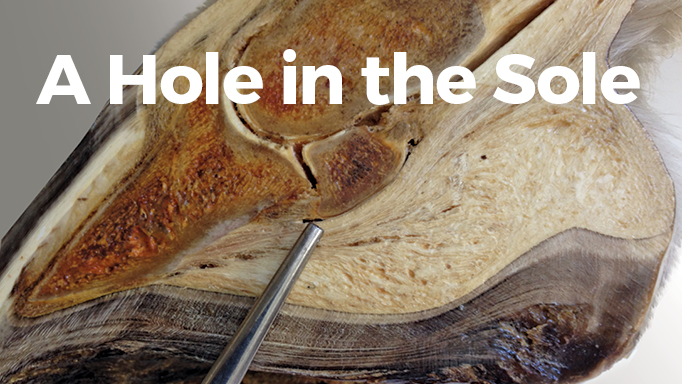You bring your horse in from the field and notice he is lame at the walk. You quickly run your hands over his leg, looking for signs of serious injury, and don’t find anything abnormal. Then you pick up his foot and find a nail sticking directly into the sole.
The first instinct is to immediately pull the nail from the foot to provide your horse with relief from the foreign object; however, this is something vets caution against. There are many important structures within the hoof that can become compromised or infected if the foreign object penetrates into that area, and if you pull the nail before radiographs are taken, it is difficult to know if the injury requires referral to a hospital or if it can be treated on the farm. Because the hoof acts as a barrier to protect those structures, it is very difficult to access them without surgery (and sometimes even with it!).
Instead, call your vet immediately, leave the nail in the foot [providing that the vet will be arriving shortly], wrap it with a protective bandage or put on a clean boot. Once at the farm, your vet will take radiographs to determine what structures are involved. If you are lucky, the penetrating injury is superficial and has missed any bone structures or tendons. If this is the case, you can treat the foot as though it has an abscess once the nail or other object has been removed. Your vet may also give a tetanus booster if your horse is not up to date on its annual vaccines or is close to renewal. A round of antibiotics may also be prescribed.
Treating an abscess or superficial penetration injury is quite simple and involves applying a foot poultice. You will need a hoof poultice pad or sheet, a roll of self-adherent bandaging tape such as Vetrap™, a roll of duct tape, and scissors. A baby diaper is useful if medications need to be applied, and a poultice boot is handy, but not necessary.
1. Start by standing your horse on a clean, dry surface, pick out the foot thoroughly and rinse it with clean water.
2. Select a poultice pad, or if using poultice sheets, cut a section to fit the sole of the hoof.
3. Wet the pad in warm water and wring out the excess.
4. Pick up the horse’s foot and place the poultice pad on the sole of the foot.
5. Wrap the foot with bandaging tape in a figure-eight pattern, covering the whole hoof, well up the pastern where the tape should be snug, but you should still be able to easily fit a finger underneath.
6. Make an 8×8-inch square of duct tape by layering in two directions perpendicular to each other. (Do this ahead of time if possible for speed of application later.)
7. Place the duct tape on the bottom of the foot and fold the excess around the heel and toe to secure, then finish with a strip of duct tape around the entire circumference of the hoof to secure it.
8. To simply medicate a foot, apply the medication to the inside of the diaper, secure around the hoof using the tabs, wrap with bandaging tape and finish with duct tape as above.
The foot poultice should be changed daily (and certainly no longer than every two days) in order to monitor any drainage from the wound. Speak with your vet to develop a treatment plan going forward.

